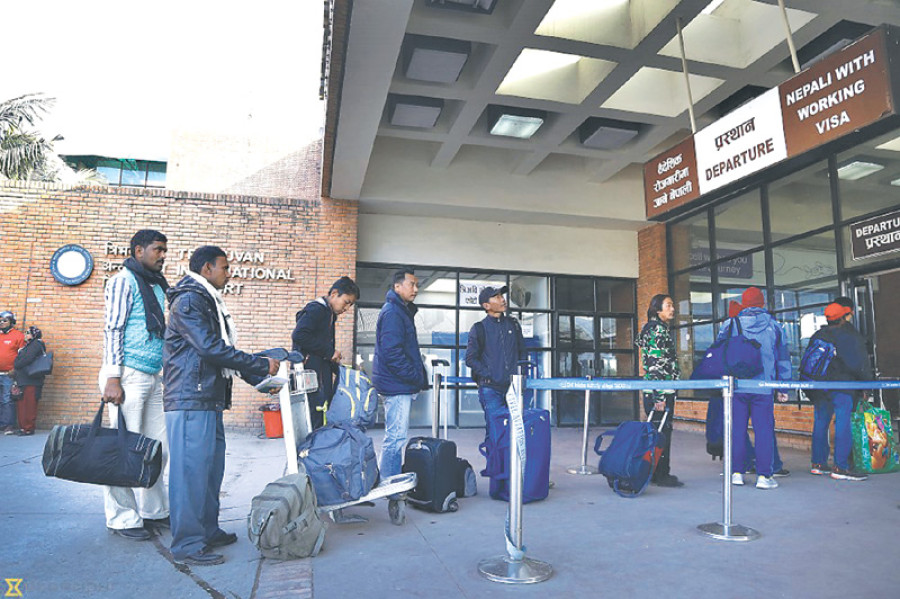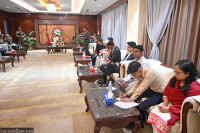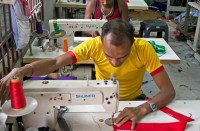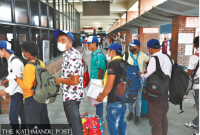Opinion
Safe, regular and orderly migration
Nepal needs dedicated policies and investment in preparing its nationals for overseas work
Paul Norton
The IOM Global Migration Trends Factsheet 2015 revealed that the number of international migrants worldwide—people residing in a country other than their country of birth—was the highest ever recorded, at 244 million (up from 232 million in 2013). It also estimated that the majority of international migrants in the world are migrant workers. These trends have led migration to be included, for the very first time, in the global development framework—recognising well-managed migration’s integral role in and contribution to sustainable development. The internationally agreed Sustainable Development Goals (SDGs) are now driving policy-planning and implementation across borders and sectors. In order to benefit from the inter-linkages between migration and development, the fundamental contributions of migrants must be recognised. Thus, the SDGs include migration- and human mobility-related aspects in 10 of the 17 SDG targets.
Inevitable, necessary, desirable
In Nepal, the Ministry of Labour and Employment recently released a new report on Nepal’s Labour Migration for Employment, which noted that foreign employment is the main reason for international migration from Nepal in the 21st century. The government advised that they have issued more than 3.8 million permits to work abroad (excluding India) for the past 21 years, which represents nearly 14 per cent of the current population. It can be understood that Nepal sees migration as an important livelihood strategy for many people in both urban and rural areas. As IOM’s Director General stated to the UN General Assembly in September, on the occasion of IOM joining the UN, migration has become ‘inevitable, necessary and desirable’. It has also been drawing the attention of policymakers and encouraging broad policy dialogue in the country to explore new development strategies that can promote ongoing economic growth.
Even so, many of Nepal’s migrants are low-skilled labourers with little formal education. Unfortunately, they often face tremendous challenges and risks associated with exploitation, both during the recruitment process and later on in all other employment phases (especially during pre-departure and employment in the destination country). Given the voluminous nature of labour migration, managing and ensuring migrants’ safety, rights and welfare is a challenge for any country, Nepal included.
IOM, as the UN Migration Agency, plays a key role to support Nepal in ensuring comprehensive and balanced national migration policies that facilitate the many forms of human mobility: labour migration at all skills levels, family unification, educational opportunities, humanitarian admissions; in working to reduce the incidence and impacts of irregular migration; and in reducing and mitigating internal
displacement. The goal is not to prevent migration, but to reduce pressures that compel forced, irregular and unsafe migration. In doing so, close cooperation is vital among government agencies and all concerned actors. These include private sector employers and recruiters, unions, civil society, diaspora groups (in countries of origin, transit and destination), as well as migrants and communities themselves.
Prevention, development and information outreach measures are needed to reduce the forces that compel migrants to leave their homes against their wishes, particularly for safety or survival reasons. These measures include all policies outside of the migration domain to reduce violence, crime, environmental degradation, natural disasters, food insecurity, restricted livelihoods and many more. Migrants should be able to choose genuinely whether they want to stay safely and productively at home, or to migrate through safe, regular migration channels.
It is a common imperative to ensure protection of the rights of all migrants at all stages of the migration process, without regard to their migratory status. Many encounter vulnerabilities along migratory routes, either because of the way they migrate (through the assistance of exploitative migrant smugglers or human traffickers, over land and by sea) or at reception (detained simply for the administrative offense of irregular entry).
Measures to prevent all forms of irregular migration have often proven to have simply rerouted existing flows. Moreover, they have created opportunities for criminal smuggling and trafficking organisations to expand business and thrive, while presenting a very real risk of hindering access to asylum and needed protection for vulnerable migrants.
65th anniversary
There are migrants who are not refugees but nonetheless face vulnerabilities and have profound needs and rights that must be addressed. Victims of trafficking, separated exploited migrant workers and unaccompanied children are just a few examples of migrants that have protection needs.
Now is a crucial time for us to rethink traditional security-oriented approaches to migration and to move towards more forward-looking policies. These must not only respect and enhance systems for the protection of migrants with vulnerabilities, but also better connect development and migration policies, as well as address labour, demographic, research and innovation needs.
Nepal needs dedicated policies and investment in preparing its nationals for overseas work, protection mechanisms throughout the migration life cycle, and return and reintegration policies. IOM, as the UN Migration Agency, and celebrating its 65th anniversary, is dedicated to working with Nepal toward accomplishing these goals.
Norton is Chief of Mission, IOM Nepal




 19.12°C Kathmandu
19.12°C Kathmandu










